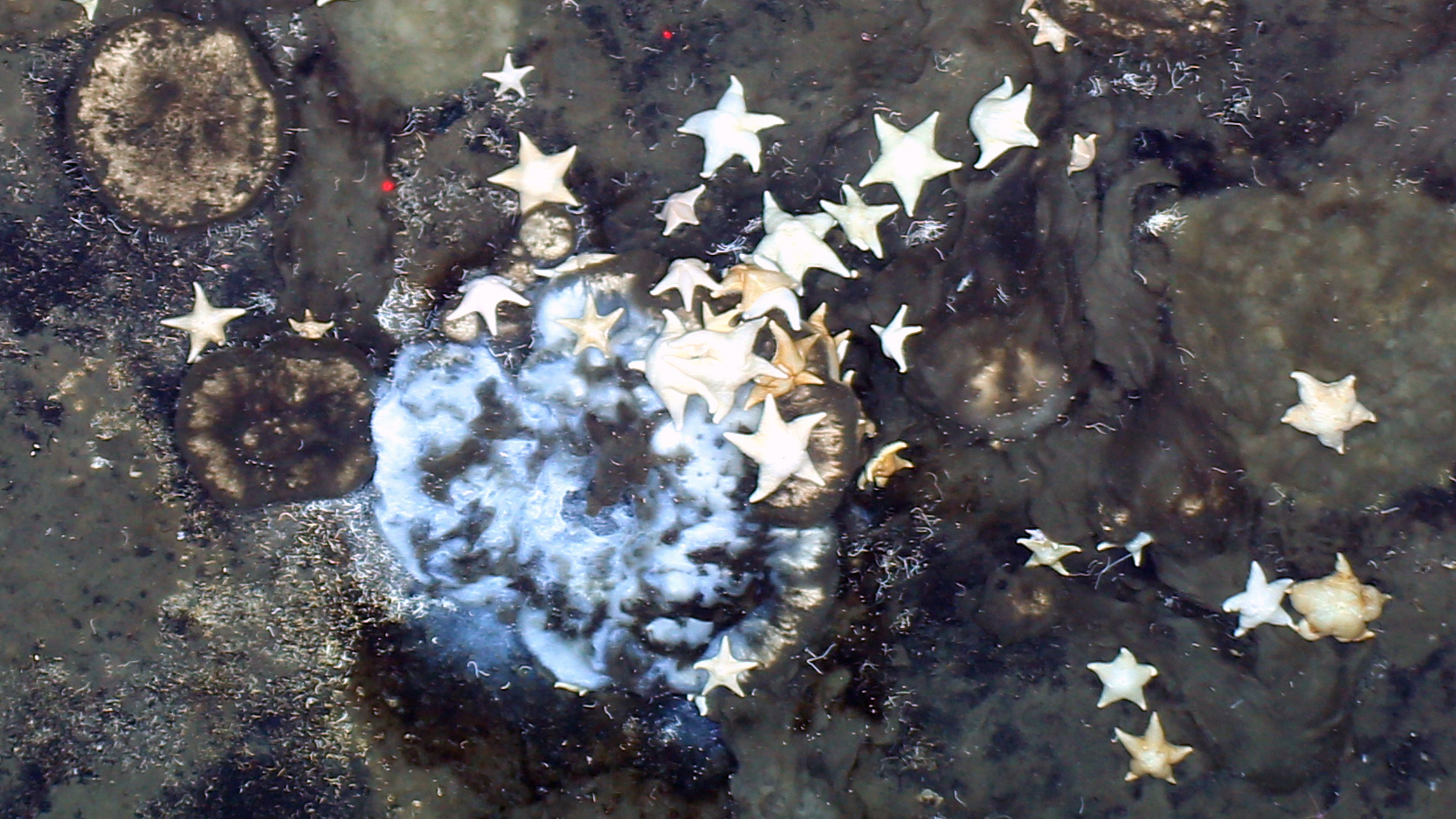300-year-old Arctic sponges feast on the corpses of their decaying, extinct neighbors
Bacteria help the sponges digest extinct creatures' remains.

On an underwater mountain in the Arctic Ocean lives a community of sponges with a ghoulish secret. With little to eat in the nutrient-poor water, the sponges survive by digesting the remains of long-dead animals that once inhabited the seamount peaks where the sponges now live. And they've been feasting on their extinct neighbors' corpses for centuries.
Scientists recently discovered these macabre creatures on the Langseth Ridge, part of a former volcanic seamount in the Central Arctic, at depths of 1,640 to 1,969 feet (500 to 600 meters) where temperatures hover just above freezing. In those icy depths, researchers found thousands of sponges covering an area measuring 5.8 square miles (15 square kilometers).
In some parts of the deep ocean where nutrients are scarce, seafloor ecosystems often cluster around hydrothermal vents (also called seeps), which provide heat and food — but volcanic activity in this part of the seamount ceased thousands of years ago. Nor are there strong ocean currents that could carry food to the sponges from above or below. But the sponges discovered a rich and plentiful food supply: dissolved compounds from a graveyard of tubeworms and bivalves that died out long ago, which the sponges digest with a little help from symbiotic bacteria.
Related: The 10 strangest places where life is found on Earth
The scientists used a camera and sensor network called the Ocean Floor Observation and Bathymetry System to capture video, still images and other data from the sponge community; they also collected samples of the sponges and their environment using a remotely operated diving robot called "Nereid Under-Ice," according to a study published Feb. 8 in the journal Nature Communications.
Not only were there thousands of sponges clustered on the seamount peaks, many of them had grown quite large, reaching up to 3 feet (1 m) in diameter, said lead study author Teresa Morganti, a postdoctoral researcher at the Max Planck Institute for Marine Microbiology in Bremen, Germany. And many of the sponges were actively reproducing, showing "substantial budding," the scientists wrote in the study.
"The main question was, 'How could such a community survive in this area?'" Morganti told Live Science. "We hypothesized that they could use a local food source — in this case, the remnants of this ancient seep community."
Get the world’s most fascinating discoveries delivered straight to your inbox.
Under the sponges, the researchers found a dense biomass made mostly of tubes left behind by marine worms that died out when the seamount's volcanic activity ceased about 2,000 to 3,000 years ago, and sponge tracks over the fossil mats showed where the sponges had foraged before settling down atop the preserved remains. Many individual sponges were at least 300 years old, and they hosted diverse microorganisms. Bacteria in the phylum Chloroflexi likely played an important part in degrading the fossilized tubeworms and releasing dissolved organic matter that kept the sponges well-fed, the study authors reported.
But if the sponges have already been in this spot for centuries — and there are now thousands of them — is their food supply in danger of running out? Probably not, as the sponges have an exceptionally slow metabolic rate, Morganti said.
"Because these are big individuals living in the central Arctic where the temperature is low, their metabolism is very low in general," she explained. "They aren't consuming this food source very fast, so I think they have plenty of food there."
However, even if the sponges' all-you-can-eat fossil corpse buffet won't be depleted anytime soon, climate change could introduce more immediate threats to the sponges' survival. The sea surface over the Langseth Ridge is typically covered with a layer of ice. But as the Arctic warms and surface sea ice melts, more nutrient particles will drift from the sea surface to the seamount below. Should food become more plentiful in the ocean depths, other marine species may start moving in and could disrupt the sponges' deep-sea habitat, Morganti said.
Originally published on Live Science.

Mindy Weisberger is a science journalist and author of "Rise of the Zombie Bugs: The Surprising Science of Parasitic Mind-Control" (Hopkins Press). She formerly edited for Scholastic and was a channel editor and senior writer for Live Science. She has reported on general science, covering climate change, paleontology, biology and space. Mindy studied film at Columbia University; prior to LS, she produced, wrote and directed media for the American Museum of Natural History in NYC. Her videos about dinosaurs, astrophysics, biodiversity and evolution appear in museums and science centers worldwide, earning awards such as the CINE Golden Eagle and the Communicator Award of Excellence. Her writing has also appeared in Scientific American, The Washington Post, How It Works Magazine and CNN.



